

The 3.5 Red Hand Of Doom Handbook for DMs [Major spoilers!] - WIP, PEACH! Consolidated Lists Archive. Work on the next iteration of Dungeons & Dragons is underway, and you can be a part of it!
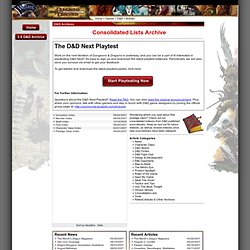
Interested in playtesting D&D Next? It's easy to sign up and download the latest playtest materials. Periodically, we will also send you surveys via email to get your feedback. To get started and download the latest playtest packet, click here: For Further Information: Questions about the D&D Next Playtest? The Duskblade's Handbook.
Spells: Duskblades have a limited list, so it's easy to comment on every spell they get.
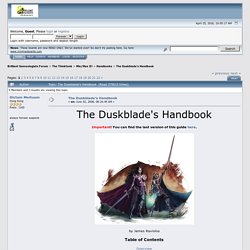
Remember not to get many spells that require saving throws to affect their targets and to avoid spells that you are not going to use much. Those are better on a wand or eternal wand. Touch of fatigue, chill touch, shocking grasp, resist energy, dimension hop, ghoul touch, touch of idiocy, dispelling touch and vampiric touch are all range:touch spells. Shocking grasp, chill touch, vampiric touch are the main damaging spells of the duskblade.Touch of fatigue, ghoul touch, touch of idiocy, dispelling touch are mainly used to debuff. Now, while the offensive uses are pretty straightforward, there can be defensive/buffing uses as well. e.g. you can channel resist energy and buff your party or greater magic weapon. It may not be much, but it becomes really interesting with spells with expensive material components. The Wizards Community. 3.5 Dragon Shaman Handbook.
Originally Posted by JopustopinI think it's that a party would almost always rather have a Dragon Shaman in the party than a Fighter.
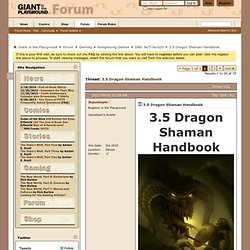
A Fighter doesn't have the flexibility to fulfill as many roles as the Dragon Shaman has available to him. A Dragon Shaman can be almost as good of a tank as a Fighter, while at the same time offer party support and act as a terrific group face. The tier system is based around flexibility & Power and, while the Dragon Shaman is more flexible than a barbarian, he's not as powerful (hence why they are in the same Tier). A Dragon Shaman is way more flexible than a Fighter and almost as good as him at the role the Fighter is supposed to fulfill.False.
Tier System for Classes. EDIT: Note this is not the most up to date version of this system, having been locked due to too many pages of discussion.
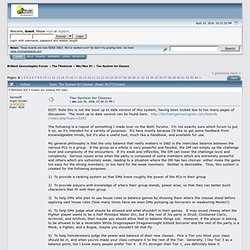
The most up to date version can be found here: The following is a repost of something I made over on the WotC forums. I'm not exactly sure which forum to put it on, as it's intended for a variety of purposes. It's here mostly because I'd like to get some feedback from knowledgeable minds, but it's also a useful tool, much like a handbook, and available for use. My general philosophy is that the only balance that really matters in D&D is the interclass balance between the various PCs in a group. 1) To provide a ranking system so that DMs know roughly the power of the PCs in their group 2) To provide players with knowledge of where their group stands, power wise, so that they can better build characters that fit with their group. 4) To help DMs judge what should be allowed and what shouldn't in their games.
The Tier System JaronK. Handbook Index. Work: Making a handbook compilation isn't a lot of work, but it's still some.
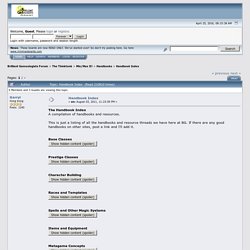
Don't dump Work, but you don't need to put a lot into it, either.Time: This is the SAD thing about handbook compilations, that most of what you need to put in is Time to copy everything into one big list.Effort: It takes a bit of effort to do this, just like everything else worthwhile. Put whatever points you have left over into Effort, and keep it at least at 12 regardless.Insight: Dump stat. Other then the usual uses, you don't need any insight to just compile a list. The 3.5 Cleric Handbook. Multi-classing General Disclaimer: An optimization rule of thumb is that caster levels are superior to other abilities.
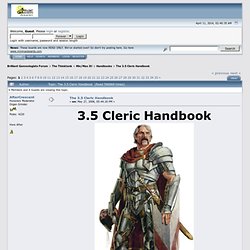
Caster levels with extra abilities are superior to even that. Basically, if at all possible, don't lose caster levels. If you must lose caster levels, never lose more than 3 in a 20th level build, and make sure the benefits greatly outweigh what you are losing. Clerics are unique in that you get all of your class abilities at the outset, so Prestige classing and Dipping into other classes is much more viable than in some other builds. The Soulknife-Soulbow Dip The standard idea with this build is to grab two levels of Soulknife for the throw mind blade class feature and then dip one level of Soulbow. ). Prestige Class Options Bone Knight5N As long as you are not barred from using Eberron books, this is one of the best cleric prestige classes around. D&D Wiki. Dungeons and Dragons Wiki. The Hypertext d20 SRD (v3.5 d20 System Reference Document)